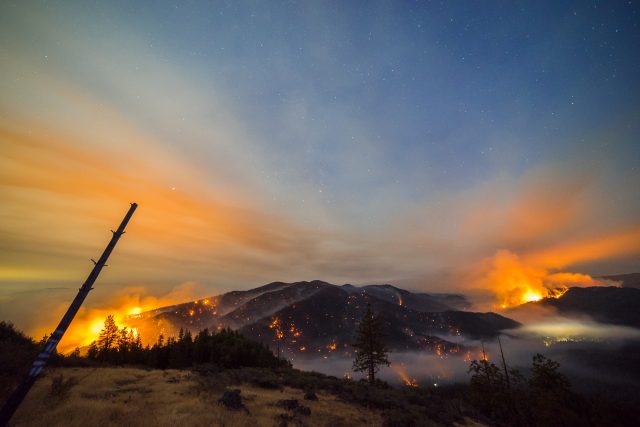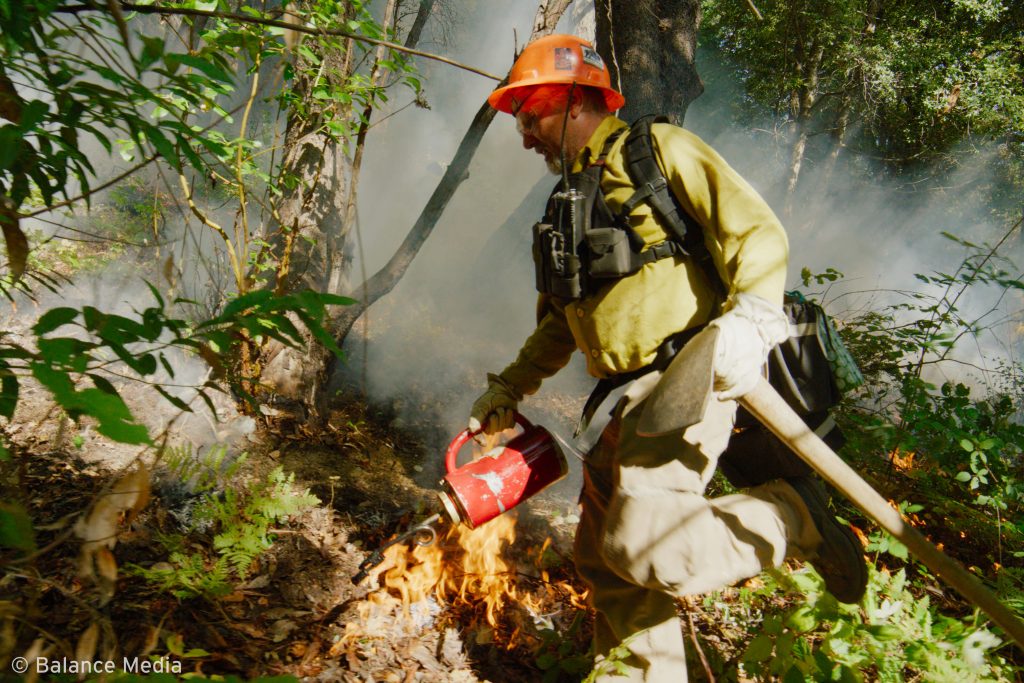
It starts in flames.
Traffic is bumper to bumper as Michelle Simmons and her kids make their way out of Paradise, California. It’s the middle of the day, but the smoke is so thick you can’t see the sun. You can almost feel the heat as Simmons drives fearfully close to the approaching inferno.
Another scene shows the charred and smoldering neighborhoods following the Marshall Fire — an eerily quiet contrast to the panic and disarray of the California fire.
Despite what its opening moments may suggest, Elemental: Reimagine Wildfire is not all destruction and darkness. Rather, the documentary combines captivating visuals with the voices of experts and people impacted by wildfire to help show solutions and tangible steps forward.
“This film allowed me to really reimagine how we think about fire, and how we can live with more fire on the landscape without these catastrophic losses of communities,” says Ralph Bloemers, executive producer of the film and a graduate of CU Boulder.
While there are plenty of discussions about different schools of thought in wildfire mitigation, Elemental focuses on the combination of home-hardening and controlled burns as the most efficient way to protect communities as wildfires become more common and severe across the West due to climate change.
But, critics say this approach doesn’t consider the whole picture.
With a June 13 digital release on Apple TV and a TBA screening planned for Nederland in July, the film comes right as Boulder County, the city of Boulder, and the Mountain View Fire Protection District are all developing new Community Wildfire Protection Plans (CWPP). These plans offer residents the opportunity to identify projects and needs across the county, from solutions like home hardening and grazing to forest thinning.
The return of fire
Before starting on a film that would take him five years to finish, Bloemers felt like the dominant narrative was “fire destroys the forest, kills wildlife, and can and must be controlled by man.”
He didn’t think that told the whole story, and took it upon himself to
prove it.

Countless hours of footage from burned forests revealed what emerges after a wildfire — a regenerated ecosystem thriving with biodiversity, from abundant wildflowers to sturdy elk.
While inspired by nature, the film ultimately focuses on avoiding human catastrophes.
“My goal is to help make our communities safe from fire and to ensure that we have a better understanding of the choices in front of us — both personally and at all levels of government spending — as we try to meet the challenge,” Bloemers said in a Q&A about the film.
Elemental starts with the limits of fire suppression. As bigger fires surpass firefighting capabilities, especially those that coincide with extreme weather such as high winds, it becomes nearly impossible to protect every home in the path of the blaze.
Then there’s forest treatments: prescribed burns, hand and mechanical thinning, slash-pile burning. It’s a common practice for land managers, but new research featured in the film shows its impact is limited. Tania Schoennagel, a researcher at CU Boulder, found that out of all the recent treatments conducted in Western forests, only 1% of them encounter fire. She says even if treatment efforts are doubled or tripled, it won’t have a significant impact on wildfire.
It can also be hard to measure success of forest treatments because they are dependent on a variety of factors like weather, terrain and slope. For example, an analysis of one fire in the film showed severity increased where land was managed. But when the 2022 Boulder NCAR Fire ran into fuel treatments, firefighters reported it increased their probability of success.
These findings ultimately led to turning fire mitigation’s gaze away from the forests, where there’s unpredictability, and toward hardening homes and communities — solutions with more predictability.
Retraining our vision
Fritz Koch with Boulder County Fire Fighters Association has worked in fire mitigation since 1996. He watched the film.
“I think it did a good job of capturing, and hopefully increasing awareness to, the need to refocus from the forest to the home,” he says.
More fire specialists like Koch are starting to shift their focus from fuels reduction in the forest to home-hardening (News, “Slow burn,” May 3, 2023), something Koch says was less valued in the past.
“Instead of standing there looking at the forest going, ‘What happens when fire comes through the forest?’ turn around and look at the house and say, ‘What happens when there’s an ember on this house?’” Koch says. “That’s where we really need to retrain our vision.”
Greg Aplet, director of special projects at the Wilderness Society, says that shift doesn’t necessarily mean avoiding work in the forest.

“People are not going to be accepting of fire in the wilderness until they feel safe in their homes, and we ought to be working on community protection,” Aplet says. “I don’t think it means that’s the only thing we ought to be doing. There are other resources out there.”
Koch uses the National Cohesive Wildland Fire Management Strategy’s “three-legged stool” of fire mitigation to guide how he addresses his work. The legs — fire-adapted communities, resilient landscapes, and safe and effective wildfire response — are meant to be given equal priority.
Some say Elemental wasn’t as balanced.
“While solid points are made by experts in the field, some topics are erroneously conflated with others and key pieces to the full story are left out,” the Association for Fire Ecology’s (AFE) wrote in response to the film.
One of AFE’s critiques include “doubt-casting” the effectiveness of fuel treatments when they have been scientifically shown to reduce wildfire intensity. While few treated areas have encountered wildfires, as shown in Schoennagel’s research, AFE writes that could be a reason to scale up those practices rather than a flaw.
Boulder County employees Stefan Reinold and Jim Webster both pointed to the AFE response to sum up their views on the film.
Aplet says homeowners should take steps to lower the probability of home ignition, but fire mitigation doesn’t stop there.
“We also have this need for more fire in fire-dependent forests, and we need to figure out how to get that fire back into the forest, or we’ll end up conceivably with protected homes and no forests,” Aplet says, adding that thinning can help reintroduce fire into forests.
Reintroduction of fire isn’t a new concept, but how we get there isn’t totally clear.
One of the most common wildfire mitigation techniques is thinning, mechanically removing built up trees and brush to better emulate historical forest structure, rather than the more dense structure found today. With less fuel to burn, lower-severity fires foster ecosystem benefits like lower tree mortality, especially if thinning is followed up by controlled burns. This is the concept many land managers use in Boulder County.
Others say thinning isn’t as important, especially in wildlands, because high-severity fire has always been part of these ecosystems, so resources should be focused on preventing communities from burning (News, “Slow burn,” May 3, 2023).
Aplet says humans should try and intervene in the forest.
“I think it really boils down to how much trust do you have in the Forest Service and the management agencies to intervene in a way that will actually leave the forest in better condition,” he says, acknowledging that while the Forest Service is incentivized to cut timber, logging in the Front Range is “almost zero.”
While Koch has a more holistic approach to mitigation, he also says “we need to pick a problem and focus on that.” While preventing community fire destruction was Elemental’s focus, he says that’s just one facet.
Depending on the goal of mitigation, from saving lives and structures to protecting ecosystems, strategies can change.
Maybe cutting trees won’t save his house, says Koch, but forest treatments might be worth it “if that saves the quality or condition of that forest for future years.”
The wildfire plan
Communities in Boulder County have the chance to influence what local fire mitigation looks like through the CWPP — a document that establishes priorities and action items related to wildfire risk reduction and resilience.
While drafting a CWPP doesn’t launch projects, having these plans in place gives the community a leg up when applying for grants.
Both the city and county’s current plans are more than 10 years old. Meg Halford with Boulder County Community Planning & Permitting says there’s a lot more collaboration, partnering and community engagement this time compared to the county’s first CWPP in 2011.
“It’s all hands on deck because our challenges have increased,” she says.

The first community engagement event is on Saturday, June 10 from 9 to 11:30 a.m. at the Superior Community Center. Its focus is on Superior, Louisville, Marshall and Eldorado Springs. Similar events, public surveys and a CWPP-dedicated website will follow throughout the year-long updating process.
The new CWPP risk assessments, all expected to be completed by SWCA Environmental Consultants, are taking a closer look at areas previously thought to have little to no wildfire risk, including urban areas and prairies, especially in East Boulder County, in addition to forested areas in West Boulder County. In Boulder’s 2007 CWPP, agricultural land was labeled as unburnable.
Kerry Webster, wildland fire senior program manager with the city of Boulder, expects both home hardening and ecosystem management projects to come from the new CWPP.
“I think it is going to have to be a little bit of a switch in mentality, that we are in a partnership altogether,” she says. “We need to work on our own properties and our own structures, and then have our land management be our partners in that and do their work on their land.”
Elemental: Reimagine Wildfire helps unpack the risks of living in fire-adapted ecosystems, and empowers people to act. Rather than thinking of wildfire as a problem that should be suppressed, it suggests communities learn to live with fire.
“That’s the definition of a fire-adapted community,” Koch says. “It’s not just structure hardening. It’s awareness. It’s getting people to communicate, getting people to prepare.”














